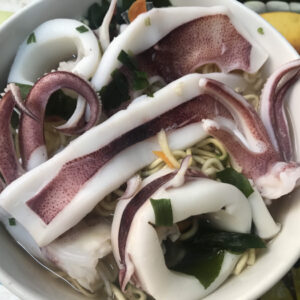Seafood (shrimp, fish, squid,…) are foods rich in nutrients, essential for humans. However, the current burning problem is that traders have abused soaking chemicals containing borax, urea, color and odor removal chemicals to keep them longer, or injecting substances to increase volume. These toxic chemicals, naturally introduced into our bodies over time, cause: weakness, memory loss, cancer… To avoid buying foods like the above, we need to be careful. Smart consumers, in order to distinguish between fresh seafood and “transformed” seafood. Below are a few pocket tips for housewives.
1. Ink
– Some places of business, or at markets, small traders use magic tricks to turn dead, rotten-smelling squid into fresh, delicious squid using chemical bleach. Or soak in water to increase its weight, causing the squid to shrink when cooked, lose its firmness, become watery and become mushy.
– Fresh squids are usually bright pink in color, the meat is thick and large, the head is still attached to the body, and the squid antennae are still attached to the head. In particular, the ink body is not scratched or abnormally deformed. The meat of these squid will also be more juicy and will not shrink when processed, preserving the flavor of your dish.
– In addition, market ladies can still choose frozen squid to maintain the original nutritional quality. How to identify squid before freezing that it is alive and fresh: The squid’s body is straight, no tail or head is missing, the squid’s antennae are attached to the head, the eye membrane is less opaque.
2. Shrimp
Have many of us made the mistake of buying impure shrimp? Can’t distinguish between clean shrimp, fresh shrimp, and “witch shrimp”? The following tips will make this job easier. To distinguish between farmed shrimp and wild shrimp, you just need to note a few tips:
– Shrimps that have been injected with chemicals will have abnormal parts of their bodies that only if we are observant we can recognize: The shrimp’s back is enlarged, the segments on the shrimp’s back are dilated. The shrimp head shell is easy to separate from the body. The shrimp is also straight, no longer naturally curved like other regular shrimp. The tail of the shrimp spreads out but the fan blades, the color of the shrimp is pale and inconsistent. When processing these shrimp, the meat shrinks and becomes watery, the shrimp meat is friable and not delicious.
– Due to reproductive characteristics, only natural sea shrimp have a blue egg strip running on the head along the spine during the breeding season. River shrimp only have eggs in the lower abdomen. The shell of sea shrimp is also thicker, the legs and antennae are sharper, and the colors are more diverse and sharper
– Natural sea shrimp have diverse colors, while farmed sea shrimp have almost identical colors. This can be explained because farmed marine shrimp live in similar conditions in terms of food source and farming water area.
3. Crab
– According to folk experience, crabs are often boiled in the middle of the month, with little meat and are not firm. Therefore, people often only buy crabs in the first or last days of the month. However, we need some other skills to help us choose delicious crabs for our family
– If the skin on the crab’s smaller claws is red or dark pink, the crab will be fatter and have more meat. However, if this layer of silk is not straight and wrinkled, it is because the crab is sick from being caught for too long.
– Try pressing the plastron with your hand. If your hand is firm, the crab is delicious and firm. If you press it and it becomes indented or soft, the crab is covered.
– Another way, use your hand to squeeze the 2nd segment of the 2nd leg (the latter is larger) if you are sure the crab is delicious.
– If there are 3 green dots on the crab’s shell, this is truly the most delicious, nutritious and meaty crab
4. Fish
– A few more tips to help housewives choose clean, fresh fish to ensure nutritious meals for your family’s health. Characteristics of fresh fish: In addition, when fish is processed or spoiled, the meat will be mushy, friable, not delicious, and fishy. If the fish is marinated in borax, the fish will develop dull black foam when cooked. Fish marinated in borax or urea will absorb toxins, causing the fish bones to be unusually dull black and not as white as fresh fish.
These toxic chemicals, when ingested for a long time, will accumulate and cannot be eliminated. Over time, they will cause our bodies to become weak, or cause other diseases such as liver, kidney, and cancer. Therefore, the above tips hope to help you gain more experience in choosing fresh, nutritious seafood for your family without “Lost money, Disability”.
– Gills still bloody or bright red
– Iridescent fish scales adhere tightly to the body, not easily peeling off the fish’s body
– The fish does not leak slimy fluid or have a bad smell
– Use your hand to press the fish. If the fish is indented, it is not fresh, fresh fish will have good elasticity
– Fresh fish has clear and green eyes. If they are cloudy, it means the fish is no longer fresh
5. Octopus
– Fresh octopus is always clear blue-white in color, soft and winding, with sticky mucus on the skin, and slightly absorbent tentacles.
– When processed, the juice does not leak, the meat is very firm and sweet and crispy
– Octopus that has been soaked in water and increased in weight will become puffy and hard without any slime, meaning the octopus is no longer fresh and juicy.
Image below: octopus has been soaked in water and chemically, the antennae of the octopus are full and bulging abnormally (Marked with X ). And the octopus’s antennae (Marked V ) are breathable, have mucus, and do not bulge.








